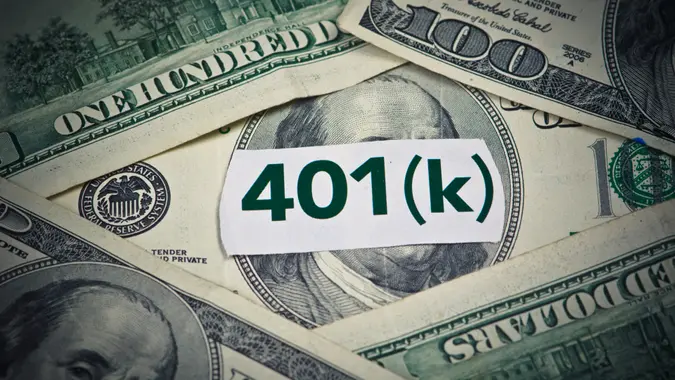I Asked Chat GPT How Much the Average Middle-Class Couple Spends Monthly in Their 80s

Commitment to Our Readers
GOBankingRates' editorial team is committed to bringing you unbiased reviews and information. We use data-driven methodologies to evaluate financial products and services - our reviews and ratings are not influenced by advertisers. You can read more about our editorial guidelines and our products and services review methodology.

20 Years
Helping You Live Richer

Reviewed
by Experts

Trusted by
Millions of Readers
It can be difficult to accurately predict exactly how much money you’re going to need for retirement, even if you use a retirement calculator with the help of a financial planner. Most people have to downgrade their expenses and make sacrifices in their lifestyles.
As someone for whom retirement is neither far off nor immediate, I wondered how much the average middle-class couple spends monthly in their 80s. After all, that’s a time when most retirees have been retired for a minimum of a decade and probably have a pretty comfortable routine, barring health issues and unexpected expenses.
I decided to ask ChatGPT to aggregate some of the vast data on the topic and give me a sense of how much the average middle-class couple spends monthly in their 80s. Here’s what it said.
The Average Monthly Spend
Using data gleaned from GOBankingRates’ surveys, the Bureau of Labor Statistics and the Employment Benefit Research Institute, ChatGPT told me that by the time an American couple reaches their 80s, the average middle-class retired couple around age 80 spends approximately $4,200 per month — or roughly $50,400 annually.
The Biggest Chunk
Naturally, the biggest share of the budget is still housing, which takes up more than one-third of expenses. ChatGPT pointed out that “even if a mortgage is long paid off, property taxes, insurance, utilities and maintenance add up quickly.”
Healthcare Is Another Big Expense
Healthcare is the next major category, representing about 13% of spending, the AI said. This includes doctor and hospital visits, prescription medications and supplemental insurance, which often can add out-of-pocket costs later in life.
Food and Transportation
Eating and getting around take up the next biggest shares of expenditures, at 13% and 15% respectively. While retirees may drive less, car insurance and upkeep expenses don’t just go away, and grocery bills rarely shrink, especially in the aftermath of recent inflation and tariff price hikes. The remaining portion of their spending goes toward “other” costs: things like personal care, insurance premiums, entertainment and gifts to family.
Their Income Sources
I was also curious about the most common sources of retirement income at this stage of life. People in their 80s today are considered “the Silent Generation,” with baby boomers largely in their 70s. These folks benefitted from costs of living that were immensely more affordable than anything their younger relatives have known. They bought homes, cars, put kids through college, went on vacations and saved money often on only one household income.
Still, even their income comes from “a patchwork of sources,” ChatGPT said. For most couples in their 80s, Social Security remains the bedrock, providing about $3,300 to $3,500 a month combined.
Of course, many took advantage of the power of compounding interest in retirement accounts and pensions. The average retiree in this age group has several hundred thousand dollars set aside, and using the common 4% withdrawal guideline, that can add another $2,500 to $3,000 a month in spending money. A few also maintain small streams of income from investments, dividends or rental properties.
They’re Financially Set
What this all adds up to is a generation of people who have more than enough income to “keep pace with expenses, at least for couples who enter retirement with moderate savings,” the AI told me. So, while they may only spend around $54,000 per year, the average household in their 80s has access to more like $73,000 a year between Social Security and savings withdrawals, leaving them a cushion for medical surprises or long-term care needs.
Location Matters
Still, geography and personal health make a big difference in how much people spend. ChatGPT pointed out that a couple living in Boston or San Francisco will likely face very different housing and healthcare costs than one living in a small Midwestern or Southern city.
What Other Generations Can Expect To Pay
While the Silent Generation and even baby boomers may be set, I also wondered how the AI would predict these numbers shaking out for my generation, Generation X, and younger generations like Gen Z.
Gen X and Gen Z are both on track to face “tougher retirements than today’s Silent Generation 80-year-olds, but in different ways,” ChatGPT said. Gen Xers will likely enter their 80s with fewer pensions, potentially reduced Social Security, higher healthcare and housing costs and longer lifespans to fund. My generation may need twice as much as Silent Generation retirees, the equivalent of $80,000 to $100,000 a year in today’s dollars just to sustain a middle-class lifestyle. Gen Zers, “coming of age in a world of high student debt, unaffordable housing and uncertain job security,” will have even greater reliance on personal savings and investing, with little expectation of traditional safety nets, the AI said. They may need well over six figures annually in today’s dollars to cover living and healthcare costs in their 80s.
So while retirement for today’s 80-year-olds looks manageable, the future for Gen X and Gen Z will be far more demanding. The earlier you plan and save, the better chance you’ll have to age with financial security.
More From GOBankingRates
- Nearly 1 in 3 Americans Hit by a Costly Holiday Scam, Norton Survey Shows -- How To Avoid This
- Here's What the Average Social Security Payment Will Be in Winter 2025
- How Middle-Class Earners Are Quietly Becoming Millionaires -- and How You Can, Too
- The Easiest Way to Score $250 for Things You Already Do
 Written by
Written by  Edited by
Edited by 


























